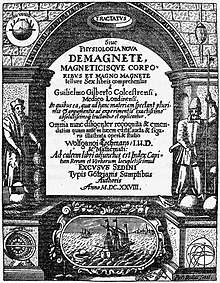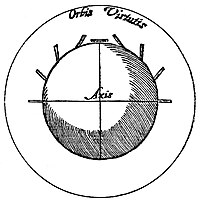
In physics, electromagnetism is an interaction that occurs between particles with electric charge via electromagnetic fields. The electromagnetic force is one of the four fundamental forces of nature. It is the dominant force in the interactions of atoms and molecules. Electromagnetism can be thought of as a combination of electrostatics and magnetism, which are distinct but closely intertwined phenomena. Electromagnetic forces occur between any two charged particles. Electric forces cause an attraction between particles with opposite charges and repulsion between particles with the same charge, while magnetism is an interaction that occurs between charged particles in relative motion. These two forces are described in terms of electromagnetic fields. Macroscopic charged objects are described in terms of Coulomb's law for electricity and Ampère's force law for magnetism; the Lorentz force describes microscopic charged particles.

Magnetism is the class of physical attributes that occur through a magnetic field, which allows objects to attract or repel each other. Because both electric currents and magnetic moments of elementary particles give rise to a magnetic field, magnetism is one of two aspects of electromagnetism.

A magnetic field is a physical field that describes the magnetic influence on moving electric charges, electric currents, and magnetic materials. A moving charge in a magnetic field experiences a force perpendicular to its own velocity and to the magnetic field. A permanent magnet's magnetic field pulls on ferromagnetic materials such as iron, and attracts or repels other magnets. In addition, a nonuniform magnetic field exerts minuscule forces on "nonmagnetic" materials by three other magnetic effects: paramagnetism, diamagnetism, and antiferromagnetism, although these forces are usually so small they can only be detected by laboratory equipment. Magnetic fields surround magnetized materials, electric currents, and electric fields varying in time. Since both strength and direction of a magnetic field may vary with location, it is described mathematically by a function assigning a vector to each point of space, called a vector field.

A magnet is a material or object that produces a magnetic field. This magnetic field is invisible but is responsible for the most notable property of a magnet: a force that pulls on other ferromagnetic materials, such as iron, steel, nickel, cobalt, etc. and attracts or repels other magnets.

Geophysics is a subject of natural science concerned with the physical processes and physical properties of the Earth and its surrounding space environment, and the use of quantitative methods for their analysis. Geophysicists, who usually study geophysics, physics, or one of the Earth sciences at the graduate level, complete investigations across a wide range of scientific disciplines. The term geophysics classically refers to solid earth applications: Earth's shape; its gravitational, magnetic fields, and electromagnetic fields ; its internal structure and composition; its dynamics and their surface expression in plate tectonics, the generation of magmas, volcanism and rock formation. However, modern geophysics organizations and pure scientists use a broader definition that includes the water cycle including snow and ice; fluid dynamics of the oceans and the atmosphere; electricity and magnetism in the ionosphere and magnetosphere and solar-terrestrial physics; and analogous problems associated with the Moon and other planets.
Timeline of electromagnetism and classical optics lists, within the history of electromagnetism, the associated theories, technology, and events.

A terrella is a small magnetised model ball representing the Earth, that is thought to have been invented by the English physician William Gilbert while investigating magnetism, and further developed 300 years later by the Norwegian scientist and explorer Kristian Birkeland, while investigating the aurora.

William Gilbert, also known as Gilberd, was an English physician, physicist and natural philosopher. He passionately rejected both the prevailing Aristotelian philosophy and the Scholastic method of university teaching. He is remembered today largely for his book De Magnete (1600).

Lodestones are naturally magnetized pieces of the mineral magnetite. They are naturally occurring magnets, which can attract iron. The property of magnetism was first discovered in antiquity through lodestones. Pieces of lodestone, suspended so they could turn, were the first magnetic compasses, and their importance to early navigation is indicated by the name lodestone, which in Middle English means "course stone" or "leading stone", from the now-obsolete meaning of lode as "journey, way".

Robert Norman was a 16th-century-English mariner, compass builder, and hydrographer who discovered magnetic inclination, the deviation of the Earth's magnetic field from the vertical.
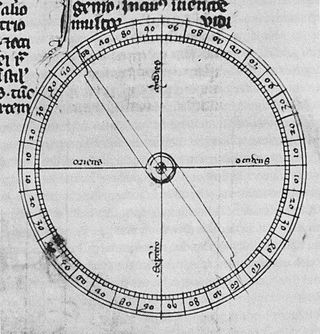
Petrus Peregrinus de Maricourt (Latin), Pierre Pelerin de Maricourt (French), or Peter Peregrinus of Maricourt, was a French mathematician, physicist, and writer who conducted experiments on magnetism and wrote the first extant treatise describing the properties of magnets. His work is particularly noted for containing the earliest detailed discussion of freely pivoting compass needles, a fundamental component of the dry compass soon to appear in medieval navigation. He also wrote a treatise on the construction and use of a universal astrolabe.
Space physics, also known as space plasma physics, is the study of naturally occurring plasmas within Earth's upper atmosphere and the rest of the Solar System. It includes the topics of aeronomy, aurorae, planetary ionospheres and magnetospheres, radiation belts, and space weather. It also encompasses the discipline of heliophysics, which studies the solar physics of the Sun, its solar wind, the coronal heating problem, solar energetic particles, and the heliosphere.
The versorium was the first electroscope, the first instrument that could detect the presence of static electric charge. It was invented in 1600 by William Gilbert, physician to Queen Elizabeth I.
Leonardo Garzoni was a Jesuit natural philosopher.
When an igneous rock cools, it acquires a thermoremanent magnetization (TRM) from the Earth's field. TRM can be much larger than it would be if exposed to the same field at room temperature. This remanence can also be very stable, lasting without significant change for millions of years. TRM is the main reason that paleomagnetists are able to deduce the direction and magnitude of the ancient Earth's field.
In the history of physics, verticity is an alleged tendency to move around or toward the North or South Pole, often called Earth's "vertices".
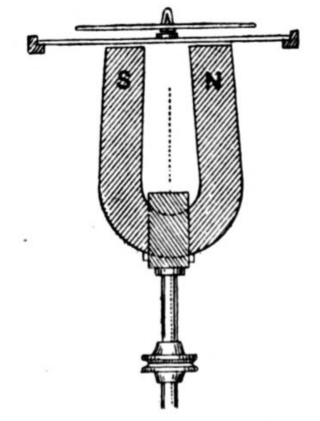
Arago's rotations is an observable magnetic phenomenon that involves the interactions between a magnetized needle and a moving metal disk. The effect was discovered by François Arago in 1824. At the time of their discovery, Arago's rotations were surprising effects that were difficult to explain. In 1831, Michael Faraday introduced the theory of electromagnetic induction, which explained how the effects happen in detail.

The history of geomagnetism is concerned with the history of the study of Earth's magnetic field. It encompasses the history of navigation using compasses, studies of the prehistoric magnetic field, and applications to plate tectonics.
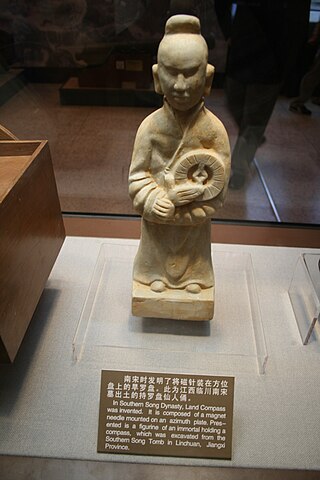
The compass is a magnetometer used for navigation and orientation that shows direction in regards to the geographic cardinal points. The structure of a compass consists of the compass rose, which displays the four main directions on it: East (E), South (S), West (W) and North (N). The angle increases in the clockwise position. North corresponds to 0°, so east is 90°, south is 180° and west is 270°.

Magnes sive de Arte Magnetica is a 1641 work by the Jesuit scholar Athanasius Kircher. It was dedicated to Emperor Ferdinand III and printed in Rome by Hermann Scheuss. It developed the ideas set out in his earlier Ars Magnesia and argued that the universe is governed by universal physical forces of attraction and repulsion. These were, as described in the motto in the book's first illustration, 'hidden nodes' of connection. The force that drew things together in the physical world was, he argued, the same force that drew people's souls towards God. The work is divided into three books: 1.De natura et facultatibus magnetis, 2.Magnes applicatus, 3.Mundus sive catena magnetica. It is noted for the first use of the term 'electromagnetism'.
